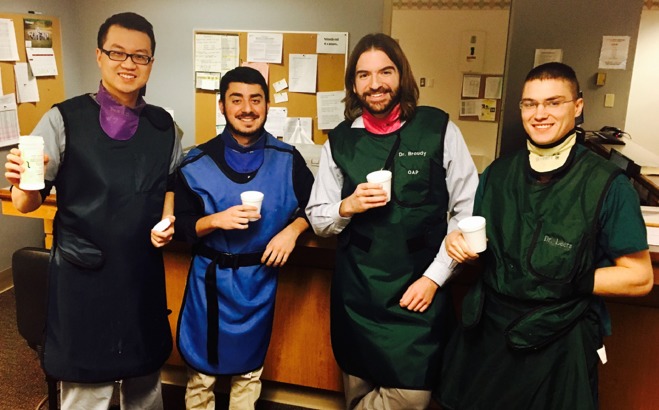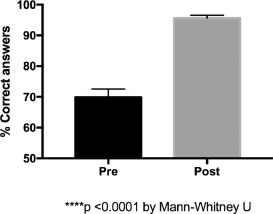Rationale and Objective
Traditionally, the radiology elective has been designed to teach medical students the fundamentals of radiologic interpretation, typically through passive means, such as didactic conferences and observational shadowing of radiologists as they interpret images. In doing so, the importance of noninterpretive skills and active learning has been minimized. Additionally, in the traditional model, students typically only gain a superficial appreciation of radiologists’ role in patient care and their interactions with clinical services, multidisciplinary teams, and patients. With the emphasis on value-focused, team-based, patient-centered care, it is important to expand the focus of radiology education beyond interpretive skills alone such that these future physicians can most effectively utilize imaging to care for patients.
Materials and Methods
A list of integrated radiology field trips was created for medical students from two institutions, Allegheny Health Network and the University of Kentucky, representing a consolidation of the instructional strategies utilized at these institutions. This paradigm uses active observation to extend learning beyond the reading room.
Results
It targets noninterpretive skills that will be of vital importance in the majority of students’ future clinical practice, such as patient safety and appropriate ordering practices.
Conclusion
This article describes the integration of nine field trip experiences into a 4-week radiology clerkship and its effect on learning outcomes and student satisfaction.
INTRODUCTION
Although the vast majority of medical students that participate in a radiology rotation will not be required to formally interpret radiologic images during their careers, nearly all physicians utilize radiologic studies to guide clinical decision-making and counsel patients on imaging examinations ( ). Despite this, the medical student radiology elective has traditionally focused heavily on teaching interpretive skills. This paradigm ignores the importance of noninterpretive skills in the future clinical practice of the majority of medical students, such as patient counseling regarding imaging examinations, appropriating ordering of imaging studies, patient safety, and professionalism. For example, the need for improved education on ordering appropriateness was underscored by a recent outcomes-based study that revealed a low level of confidence for understanding of the proper study to order ( ).
Regarding instruction, traditional radiology electives have predominately utilized passive means of teaching, such as didactic conferences and observational shadowing of radiologists during image interpretation. Medical student responsibilities have the potential to be minimal while on service and are often limited to observerships ( ). This has led to the stereotypical view of the radiology elective as a passive rotation with few expectations of the medical student. Such passive observation also negates the positive impact of active learning on outcomes.
Get Radiology Tree app to read full this article<
Get Radiology Tree app to read full this article<
Get Radiology Tree app to read full this article<
DESIGN
Get Radiology Tree app to read full this article<
Get Radiology Tree app to read full this article<
Table 1
Radiology Field Trips
CHEST RADIOGRAPHY • Observe a chest radiograph performed by the technologist with the images transferred to the picture archiving and communication system (PACS) ________ (initial) • For bonus, read out that chest radiograph with the attending or resident ________ (initial) Question to answer: • Will the heart appear larger on an AP or PA radiograph? Why?BODY CT • Observe a contrast enhanced CT scan with the CT techs (ideally a multiphasic study such as CTU) ________ (initial) • Observe the administration of intravenous contrast ________ (initial) and acquisition of images ________ (initial) Questions to answer: • Describe the classification of contrast reactions and the first-line treatment for mild, moderate, and severe reactions. • What is the GFR cutoff for a contrast-enhanced CT at this institution? • Is shellfish allergy a contraindication to getting iodinated contrast? • Name three studies in which intravenous or oral contrast should not be utilized.MRI/ MUSCULOSKELETAL • Some patients have an arthrogram in order to inject contrast into the joint in question, followed by MRI characterization. Observe an arthrogram. Following the procedure, and after reviewing the MRI safety module, follow the patient to MRI and observe their MRI post arthrogram ________ (initial) • Review and attach a copy of the MRI screening sheet to this form ________ (initial) Questions to answer: • What are three ( ) patient factors that affect MR image quality? • What is the benefit of/information obtained by injecting contrast directly into the joint? • What is the difference in time between a MRI study and CT study?ULTRASOUND/ CT PROCEDURE • Observe an ultrasound or CT-guided drainage from beginning to end including the consent process ________ (initial) • Observe an image-guided biopsy and interpret the specimen with the cytopathologist ________ (initial) Questions to answer: • What patient factors may preclude an ultrasound guided biopsy/drainage and make a CT guided procedure easier? • What size catheter is typically used for a paracentesis? • How do you remove a pigtail catheter? Why? • What lab values need to be checked prior to a biopsy? Is there a difference in requirements for a deep and superficial biopsy/drainage?FLUOROSCOPY • Observe a modified barium swallow and ask the speech pathologist how they assess for aspiration ________ (initial) • Observe an esophagram to rule out a postoperative leak ________ (initial) Questions to answer: • If a patient has a documented allergic-like reaction to intravenous iodinated contrast, do they need to be premedicated for iodinated oral contrast studies? • What is the protocol for premedication for contrast allergies? • What type of contrast is used for postoperative fluoroscopic studies of the bowel? Why?NEURO • Observe an image-guided lumbar puncture from beginning to end including the consent process ________ (initial) Questions to answer: • Describe the patient positioning and expected needle trajectory. • Regarding patient preparation, what needs to be done before a patient should have a lumbar puncture?MAMMOGRAPHY • Observe both a screening and a diagnostic mammogram ________ (initial) Questions to answer: • Describe the differences between a screening and a diagnostic mammogram. • Describe the BIRADs nomenclature with respect to cancer risk and follow up.INTERVENTIONAL RADIOLOGY • Review the preprocedure checklist with the radiology resident for venous access procedures and biopsies ________ (initial) Questions to answer: • For port placements, what is the target INR and platelet count? • What does PICC stand for? How is it different from an internal jugular/subclavian catheter?NUCLEAR MEDICINE • Observe the acquisition of images for a PET CT ________ (initials) Question to answer: • Describe at least three ( ) quality measures that are used to prevent false positives and false negatives on PET CT.
AP, anteroposterior; BIRADs, breast imaging reporting and data systems; CT, computed tomography; GFR, glomerular filtration rate; MRI, magnetic resonance imaging; PA, posteroanterior; PET-CT, Positron Emission Tomography-Computed Tomography.
Get Radiology Tree app to read full this article<
Get Radiology Tree app to read full this article<
Get Radiology Tree app to read full this article<
Get Radiology Tree app to read full this article<
Table 2
Quiz Questions
1. Describe the signs for contrast reactions: mild, moderate, and severe. 2. Is anaphylaxis to shellfish a contraindication to receiving intravenous iodinated contrast? Why? 3. List two common metal implants that are contraindications to MRI studies.` 4. Describe how to safely remove a locking pigtail catheter. 5. List two patient factors and/or artifacts that result in suboptimal ultrasound image quality. 6. What are the indications for a modified barium swallow versus an esophagram? 7. Which type of contrast agent should be used to evaluate for a postoperative leak? Why? 8. List two contraindications to a lumbar puncture. 9. List two complications of a lumbar puncture and describe their initial management. 10. Describe the differences between AP and PA projections on chest radiography and the effect on apparent heart size. 11. Label the “moguls” on this PA radiograph of the chest. 12. Regarding technique and indications, what is the difference between a screening and a diagnostic mammogram? 13. List the BIRADs categories and describe their meaning/significance. 14. What laboratory values need to be obtained before consulting interventional radiology for a procedure such as a biopsy or drainage? 15. List two patient preparation factors for a PET-CT. 16. After a patient has received chemoradiation therapy, how long should you wait to order a follow up PET-CT? Why?
AP, anteroposterior; BIRADs, breast imaging reporting and data systems; MRI, magnetic resonance imaging; PA, posteroanterior; PET CT, positron emission tomography-computed tomography.
Get Radiology Tree app to read full this article<
Required Radiology Targeted Learning Experiences
Chest Radiography
Get Radiology Tree app to read full this article<
Computed Tomography/Contrast Safety
Get Radiology Tree app to read full this article<
Get Radiology Tree app to read full this article<
Musculoskeletal/MRI Safety
Get Radiology Tree app to read full this article<
Ultrasound and CT Procedures
Get Radiology Tree app to read full this article<
Fluoroscopy
Get Radiology Tree app to read full this article<
Get Radiology Tree app to read full this article<
Neuroradiology Procedures
Get Radiology Tree app to read full this article<
Mammography
Get Radiology Tree app to read full this article<
Interventional Radiology
Get Radiology Tree app to read full this article<
Nuclear Medicine and Positron Emission Tomography–Computed Tomography
Get Radiology Tree app to read full this article<
RESULTS
Get Radiology Tree app to read full this article<
Get Radiology Tree app to read full this article<
Get Radiology Tree app to read full this article<
Get Radiology Tree app to read full this article<
Get Radiology Tree app to read full this article<
Get Radiology Tree app to read full this article<
DISCUSSION
Get Radiology Tree app to read full this article<
Get Radiology Tree app to read full this article<
Get Radiology Tree app to read full this article<
Get Radiology Tree app to read full this article<
Get Radiology Tree app to read full this article<
Get Radiology Tree app to read full this article<
Get Radiology Tree app to read full this article<
Get Radiology Tree app to read full this article<
Get Radiology Tree app to read full this article<
Acknowledgment
Get Radiology Tree app to read full this article<
References
1. Poot JD, Hartman MS, Daffner RH: Understanding the US medical school requirements and medical students’ attitudes about radiology rotations. Acad Radiol 2012; 19: pp. 369-373.
2. Saha A, Roland RA, Hartman MS, et. al.: Radiology medical student education: an outcome-based survey of PGY-1 residents. Acad Radiol 2013; 20: pp. 284-289.
3. Monks D, Pagano B, Hartman M: Spending an evening in the dark: the radiology medical student call experience. Curr Probl Diagn Radiol 2017; 46: pp. 369-372.
4. Richardson D, Birge B: Teaching physiology by combined passive (pedagogical) and active (andragogical) methods. Am J Physiol 1995; 268: pp. S66-S74.
5. Foord-May L: A faculty’s experience in changing instructional methods in a professional physical therapist education program. Phys Ther 2006; 86: pp. 223-235.
6. Rajan TV: Making medical education relevant. Chron High Educ 2006; 52: pp. B20.
7. Bonwell C, Eison J Active learning: creating excitement in the classroom. ASHE-ERIC Higher Education Report No 1. 1991; Washington, D.C.: The George Washington University, School of Education and Human Development.
8. Graffam B.: Active learning in medical education: strategies for beginning implementation. Med Teach 2007; 29: pp. 38-42.
9. Hartman M, Silverman J, Spruill L, et. al.: Radiologic-pathologic correlation-an advanced fourth-year elective: how we do it. Acad Radiol 2016; 23: pp. 889-893.
10. Gunderman RB, Hill DV: Student concerns and misconceptions about a career in radiology. Acad Radiol 2012; 19: pp. 366-368.
11. Dillon JE, Slanetz PJ: Teaching evidence-based imaging in the radiology clerkship using the ACR appropriateness criteria. Acad Radiol 2010; 17: pp. 912-916.
12. Hilmes MA, Hyatt E, Penrod CH, et. al.: Radiology in medical education: a pediatric radiology elective as a template for other radiology courses. J Am Coll Radiol 2016; 13: pp. 320-325.

